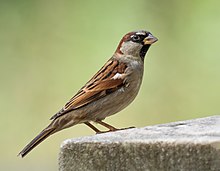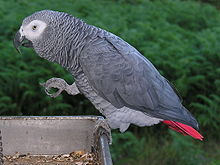Psittacopasseres
| Psittacopasseres | |
|---|---|

| |
| House sparrow, Passer domesticus | |

| |
| Grey parrot, Psittacus erithacus | |
| Scientific classification | |
| Domain: | Eukaryota |
| Kingdom: | Animalia |
| Phylum: | Chordata |
| Class: | Aves |
| Clade: | Eufalconimorphae |
| Clade: | Psittacopasseres Suh et al., 2011 |
| Subtaxa | |
| |
| Synonyms | |
|
Psittacopasserae Suh et al., 2011 | |
Psittacopasseres is a taxon of birds consisting of the Passeriformes (passerines, a large group of perching birds) and Psittaciformes (parrots).[3] Per Ericson and colleagues, in analysing genomic DNA, revealed a lineage comprising passerines, psittacines and Falconiformes.[4] The group was proposed following an alignment of nuclear intron sequences by Shannon Hackett et al. in 2008.[5] It was formally named as Psittacopasserae in a 2011 Nature Communications article by Alexander Suh and other authors working with Jürgen Schmitz's group,[6] based on genetic analysis of the insertion of retroposons into the genomes of key avian lineages over the course of evolution during the Mesozoic Era.[clarification needed]
Significance in the evolution of birdsong
[edit]Passerines are renowned as songbirds (technically this word refers to a clade of passerines), and parrots share a capacity for vocal learning. Thus it is possible that vocal learning, and the corresponding variety of song, was present in a psittacopasseran ancestor.[6]
References
[edit]- ^ Boles, Walter E. (1997). "Fossil songbirds (Passeriformes) from the Early Eocene of Australia". Emu. 97 (1): 43–50. Bibcode:1997EmuAO..97...43B. doi:10.1071/MU97004.
- ^ Kuhl., H.; Frankl-Vilches, C.; Bakker, A.; Mayr, G.; Nikolaus, G.; Boerno, S. T.; Klages, S.; Timmermann, B.; Gahr, M. (2020). "An unbiased molecular approach using 3'UTRs resolves the avian family-level tree of life". Molecular Biology and Evolution. 38: 108–127. doi:10.1093/molbev/msaa191. PMC 7783168. PMID 32781465.
- ^ Sangster, George; Braun, Edward L.; Johansson, Ulf S.; Kimball, Rebecca T.; Mayr, Gerald; Suh, Alexander (2022-01-01). "Phylogenetic definitions for 25 higher-level clade names of birds" (PDF). Avian Research. 13: 100027. Bibcode:2022AvRes..1300027S. doi:10.1016/j.avrs.2022.100027. ISSN 2053-7166.
- ^ Ericson, P. G. P.; Anderson, C. L.; Britton, T.; Elzanowski, A.; Johansson, U. S.; Källersjö, M.; Ohlson, J. I.; Parsons, T. J.; Zuccon, D.; Mayr, G. (2006). "Diversification of Neoaves: integration of molecular sequence data and fossils". Biology Letters. 2 (4): 543–547. doi:10.1098/rsbl.2006.0523. PMC 1834003. PMID 17148284.
- ^ Shannon J. Hackett; et al. (2008-06-07). "A Phylogenomic Study of Birds Reveals Their Evolutionary History". Science. 320 (5884): 1763–1768. Bibcode:2008Sci...320.1763H. doi:10.1126/science.1157704. PMID 18583609. S2CID 6472805.
- ^ a b Alexander Suh; et al. (2011-08-23). "Mesozoic retroposons reveal parrots as the closest living relatives of passerine birds". Nature Communications. 2 (8): 443. Bibcode:2011NatCo...2..443S. doi:10.1038/ncomms1448. PMC 3265382. PMID 21863010.
